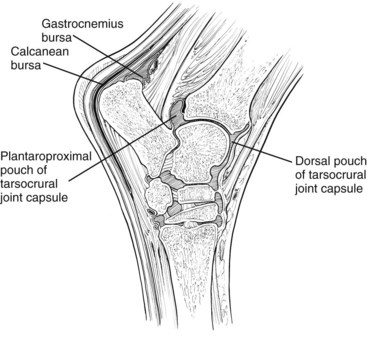Chapter 79Bursae and Other Soft Tissue Swellings
Trochanteric Bursa
The Editors have no clinical experience of trochanteric bursitis. This condition is discussed further in Chapter 47.
Calcaneal Bursa
The calcaneal or intertendonous bursa lies between the tendons of the gastrocnemius and the superficial digital flexor muscles, proximal to the hock, and extends distally on the plantar aspect of the calcaneus to the distal aspect of the hock (Figure 79-1). In most horses a communication exists between the calcaneal bursa and the gastrocnemius bursa. There is communication between the calcaneal bursa and the subcutaneous bursa in 37% of horses.
Injuries of the calcaneal bursa are not common and are usually the result of trauma. However, mild distention of the calcaneal bursa often is seen with gastrocnemius tendonitis (see page 803). Mild distention also may be seen unilaterally or bilaterally, as an incidental finding unassociated with lameness.5 Primary inflammation of the bursa results in acute-onset lameness associated with distention of the bursa. Hemorrhage into the bursa also may occur. Conservative management by rest, with or without injection of short-acting corticosteroids, usually results in resolution of lameness, although enlargement of the bursa may persist.
More commonly, infection of the bursa is caused by a penetrating injury or is secondary to infectious osteitis of the calcaneus6,7 (see Chapter 44).
Stay updated, free articles. Join our Telegram channel

Full access? Get Clinical Tree



